Florida’s housing market continue to grow
All indicators point to a strong Florida housing market next year – increasing demand, tight housing inventory, ultra low mortgage rates, robust economic growth, falling unemployment.

During the year to Q3 2019, the Federal Housing Finance Agency’s seasonally-adjusted purchase-only Florida house price index rose by 4.99% (3.18% inflation-adjusted), its 31st consecutive quarter of y-o-y growth. The index increased 1% q-o-q during the latest quarter (0.8% inflation-adjusted).
This was supported by figures from Florida Realtors, which showed that the statewide median price for existing single-family homes rose by 3.6% y-o-y to US$263,000 in October 2019. Likewise, the median price for condo-townhouse properties was up by 5.8% y-o-y to US$190,500.
Demand remains strong. Sales of single-family homes rose by 4.3% to 246,721 units in the first ten months of 2019, according to Florida Realtors. Likewise, the total sales value of single-family home sales increased 6.1% y-o-y to US$85.3 billion over the same period.
All 22 metropolitan statistical areas tracked by Florida Realtors saw rising home sales during the first ten months of 2019.
Yet inventory remains tight. The total number of active listings for single-family homes fell by 7% y-o-y to 87,616 units in October 2019, and down by 3.7% to 52,067 units for condos and townhouses. The situation is expected to ease in coming months, with new private housing units authorized in Florida rising by 9.9% y-o-y to 130,588 units in the first ten months of 2019, according to the Federal Reserve Bank of St. Louis.
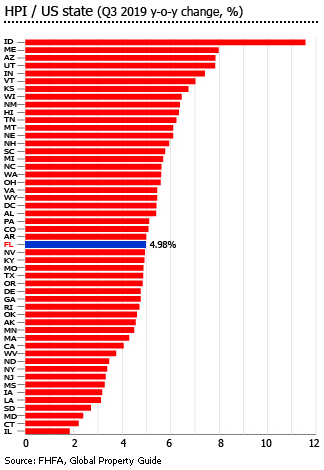
Florida is one of the most populated states in the United States. Many of its cities are heavily dependent on retirees, with residents aged 60 years and older comprising more than 20% of the population. In fact in Naples, they make up more than 61%.
“Florida continues to attract new residents and businesses,” said Florida Realtors President Eric Sain. “In fact, our population is growing by about 906 new residents every day, or more than 300,000 people a year – that’s like adding a city about the size of Orlando every year, according to a recent report from state economists. This population growth, a current unemployment rate of 3.4% and a favorable jobs outlook continue to keep Florida’s economy strong.”
Highest and lowest house price rises
Seventeen of the 22 metropolitan statistical areas tracked by Florida Realtors recorded house price increases this year. Lakeland-Winter Haven registered the biggest price growth during the year to October 2019 at 8.8%, followed by Tallahassee (8.2%), Gainesville (6.5%), North Port-Sarasota-Bradenton (6%), Orlando-Kissimmee-Sanford (5.9%), Ocala (5.4%), Port St. Lucie (5.4%), Pensacola-Ferry Pass-Brent (5.3%).
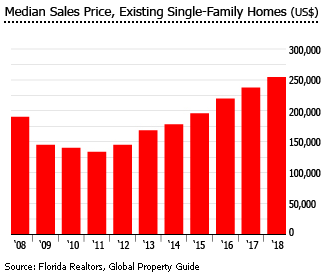
More modest house price rises were seen in Sebastian-Vero Beach (4.9%), Tampa-St.Petersburg-Clearwater (4.7%), Deltona-Daytona Beach-Ormond Beach (4.7%), Jacksonville (4.5%), Palm Bay-Melbourne-Titusville (4.3%), Cape Coral-Fort Myers (3.6%), Miami-Fort Lauderdale-West Palm Beach (2.9%), The Villages (2%), and Homosassa Springs (1.8%).
In contrast, house prices have fallen in Panama City (-6.6%), Crestview-Fort Walton Beach-Destin (-5.7%), Naples-Immokalee-Marco Island (-5.5%), Sebring (-0.9%), and Punta Gorda (-0.4%).
Rental yields range from good to excellent
Gross rental yields - gross returns on purchase price if a home is rented out - can be excellent in Florida, ranging from 5.4% to 12.3% in 2019, according to ATTOM Data Solutions’ 2019 Single Family Rental Report.
Hernando, Tampa-St. Petersburg-Clearwater had the highest yields of 12.3% in 2019. It was followed by Escambia, Pensacola-Ferry Pass-Brent; Bay, Panama City; and Pasco, Tampa-St. Petersburg-Clearwater, all with 11.4% gross yields. Other places with excellent yields included Highlands, Sebring, with gross rental yields of 10.6%; Citrus, Homosassa Springs (10.4%); Duval, Jacksonville (10.1%); and Volusia, Deltona-Daytona Beach-Ormond Beach (10%).
FLORIDA GROSS RENTAL YIELDS, 2019 |
||
| County | Metro Area | Gross Yields |
| Hernando | Tampa-St. Petersburg-Clearwater | 12.30% |
| Escambia | Pensacola-Ferry Pass-Brent | 11.40% |
| Bay | Panama City | 11.40% |
| Pasco | Tampa-St. Petersburg-Clearwater | 11.40% |
| Highlands | Sebring | 10.60% |
| Citrus | Homosassa Springs | 10.40% |
| Duval | Jacksonville | 10.10% |
| Volusia | Deltona-Daytona Beach-Ormond Beach | 10.00% |
| Marion | Ocala | 9.90% |
| Saint Lucie | Port St. Lucie | 9.60% |
| Charlotte | Punta Gorda | 9.20% |
| Lake | Orland0-Kissimmee-Sanford | 9.00% |
| Osceola | Orland0-Kissimmee-Sanford | 8.90% |
| Flagler | Deltona-Daytona Beach-Ormond Beach | 8.80% |
| Polk | Lakeland-Winter Haven | 8.80% |
| Brevard | Palm Bay-Melbourne-Titusville | 8.70% |
| Leon | Tallahassee | 8.60% |
| Alachua | Gainesville | 8.60% |
| Hillsborough | Tampa-St. Petersburg-Clearwater | 8.60% |
| Broward | Miami-Fort Lauderdale-West Palm Beach | 8.50% |
| Okaloosa | Crestview-Fort Walton Beach-Destin | 8.40% |
| Pinellas | Tampa-St. Petersburg-Clearwater | 8.40% |
| Sarasota | North Port-Sarasota-Bradenton | 8.30% |
| Indian River | Sebastian-Vero Beach | 8.20% |
| Santa Rosa | Pensacola-Ferry Pass-Brent | 8.00% |
| Orange | Orland0-Kissimmee-Sanford | 7.90% |
| Clay | Jacksonville | 7.80% |
| Seminole | Orland0-Kissimmee-Sanford | 7.60% |
| Manatee | North Port-Sarasota-Bradenton | 7.50% |
| Miami-Dade | Miami-Fort Lauderdale-West Palm Beach | 7.50% |
| Palm Beach | Miami-Fort Lauderdale-West Palm Beach | 7.40% |
| Lee | Cape Coral-Fort Myers | 6.90% |
| Martin | Port St. Lucie | 6.10% |
| Sumter | The Villages | 5.90% |
| Collier | Naples-Immokalee-Marco Island | 5.70% |
| Saint Johns | Jacksonville | 5.40% |
| Source: ATTOM Data Solutions | ||
Florida remains the top destination for foreign homebuyers
Florida’s housing market is buoyed primarily by foreign investors rather than local homebuyers. In fact, one in 5 foreign buyers in the US purchased their properties in Florida, according to NAR. About 41% of Canadian buyers, often referred to as snow birds, purchased in Florida.
“Many Canadians and other foreigners found Florida so enticing because of its lenient tax laws,” said NAR’s chief economist Lawrence Yun.
Similar to the national trend, Florida’s residential property sales to foreign buyers fell by 5% y-o-y to US$22.9 billion last year, according to Florida Realtors.

“The main challenge that faced both domestic and foreign buyers was the low supply of homes for sale compared to housing demand,” Florida Realtors said. “A stronger dollar also made a home purchase more expensive for foreign buyers from Venezuela and Brazil.”
Latin American and Caribbean buyers made up 36% of Florida foreign buyers, followed by Canadians (22%), Europeans (19%) and Asians (11%). About 67% of foreign buyers paid their transactions in cash.
Miami-Fort Lauderdale-West Palm Beach accounted for 54% of all sales to foreigners in Florida in 2018, followed by Orlando-Kissimmee-Sanford (9%), Tampa-St. Petersburg-Clearwater (9%), North Point-Sarasota-Bradenton (5%), and Cape Coral-Fort Myers (5%).
Demand remains strong
All 22 metropolitan statistical areas saw rising home sales during the first ten months of 2019. In major areas:
- In Tampa-St. Petersburg-Clearwater, sales of single-family homes rose by 3.8% y-o-y to 42,304 units
- In Miami-Fort Lauderdale-West Palm Beach, home sales increased slightly by 0.5% y-o-y to 39,467 units
- In Orlando-Kissimmee-Sanford, home sales rose by 4.2% y-o-y to 30,336 units
- In Jacksonville, home sales rose by 7% y-o-y to 21,600 units
Cash sales, which accounted for almost one-fourth of total sales, dropped 2.9% y-o-y to 59,995 units over the same period. This implies that an increasing number of buyers take out mortgage to finance their home purchases.

Both the median time to contract and median time to sale were unchanged in October 2019 from a year ago, at 40 days and 82 days, respectively.
Tight inventory
Statewide inventory of single-family homes, condos and townhouses is falling.
- Single-family homes: new listings fell slightly by 0.5% y-o-y to 315,646 units in the first ten months of 2019, according to Florida Realtors. As a result, the total number of active listings fell by 7% y-o-y to 87,616 units in October 2019.
- Condos and townhouses: new listings fell by 3.9% y-o-y to 135,961 units in Jan-Oct 2019, and active listings were down by 3.7% to 52,067 units in October 2019.

Inventory was at 3.7 months supply for single-family homes and 5.4 months supply for condos and townhouses in October 2019, according to Florida Realtors.
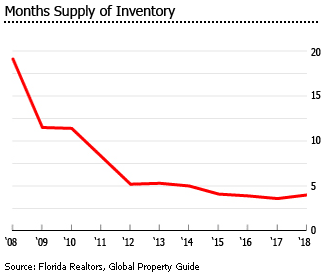
Residential construction rising
In the first ten months of 2019, new private housing units authorized in Florida rose by 9.9% to 130,588 permits as compared to the same period last year, according to the Federal Reserve Bank of St. Louis. There were more than 64,100 new housing starts in Florida in the first three quarters of 2019, up 2% from a year ago, according to Home Builders Weekly’s Q3 2019 review.
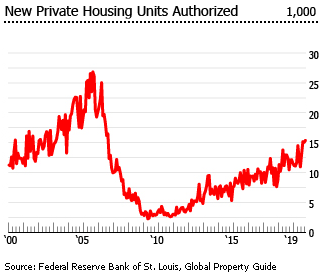
Half of the six major regions reviewed have experienced an increase in residential construction. During the first three quarters of 2019:
- West Florida registered the biggest y-o-y increase in new housing starts of 17% to 15,265 units. It accounted for one-fourth of all residential construction.
- In Southeast Florida, starts rose by 2% y-o-y to around 7,580 units
- In Northwest Florida, housing starts increased slightly by 1% y-o-y to about 8,270 units
- In Northeast Florida, housing starts were almost unchanged at 10,789 units
- In Southwest Florida, housing starts fell by 2% y-o-y to 11,610 units
- In Central Florida, housing starts fell by 7% y-o-y to 10,600 units
Interest rates falling, average mortgage debt remains low
Mortgage interest rates are falling:
- The average interest rate for 30-year fixed rate mortgages (FRMs) was 3.7% in November 2019, down from 4.87% in November 2018.
- The average rate for 15-year FRMs was 3.16% in November 2019, down from 4.28% a year earlier.
- The average rate for 5-year adjustable rate mortgages (ARMs) fell to 3.41% in November 2019 from 4.11% a year earlier.
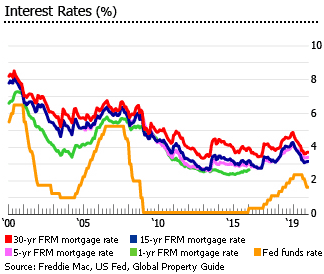
The decline is because the Fed Funds target rate was lowered to 1.75%-2% in September 2019 and further to 1.5%-1.75% in October 2019. During its December meeting, the central bank indicated that it intends to hold rates steady in 2020.
Buoyed by falling interest rates, Florida’s average mortgage debt per borrower rose by 2% y-o-y to US$187,440 this year, according to Experian. Yet it is 7% lower than the national average mortgage debt of US$202,284.
Nationwide, the size of the mortgage market was equivalent to 75% of GDP in 2018, far lower than the 100.1% of GDP in 2009.
Foreclosure filings rising, distressed home sales falling
Florida was among the top 5 states with the highest foreclosure rates, at one in every 1,571 housing units – far higher than the national average of one in every 2,453 units, according to Attom Data Solutions. Despite this, the foreclosure rate remains at sustainable levels.
“The latest number is still below where it was a year ago and less than 15% of what it was during the depths of the Great Recession,” said Todd Teta, chief product officer with ATTOM Data Solutions.
Closed sales for foreclosed/REO homes in Florida fell by 12.2% to 1,829 units in Q3 2019 from a year earlier, according to Florida Realtors. Likewise, short sales dropped 20.1% to 496 units over the same period.
Homeownership rate rising gradually
Florida’s homeownership rate stood at 65.5% in Q3 2019, according to the US Census Bureau - slightly higher than the national average of 64.8%. Florida’s homeownership rate reached a peak of 72.4% in 2006, right before the global financial crisis.

Rents continue to rise
In October 2019, the average rent of homes in Florida rose by 3.3% y-o-y to US$1,714 per month, according to Zillow Rent Index.
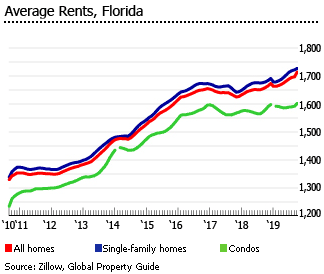
By property type:
- For single-family homes, the average monthly rent was US$1,727 in October 2019, up 2.9% from the previous year
- For condos, the average monthly rent stood at US$1,602, up 1.4% a year earlier
In October 2019, Naples-Immokalee-Marco Island Metro and Key West Metro had the most expensive rental housing in Florida, with average monthly rents of US$3,293 and US$3,243, respectively.
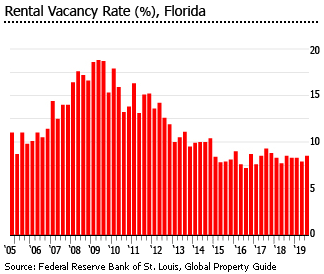
The rental vacancy rate in Florida was 8.5% in Q3 2019, up from 7.9% in the previous quarter but unchanged from a year earlier, based on figures by the U.S. Census Bureau. It was far higher than the national vacancy rate of 6.8%.
Housing affordability worsens
Housing affordability is a major concern in Florida, particularly in Miami-Dade County. Based on the RealtyHop Housing Affordability Index in October 2019, Miami, FL was ranked as the third least affordable cities for homeowners in the country, next to New York, NY and Los Angeles, CA. Accordingly, the average family needs to spend a whooping 84.4% of annual income to own a standard home in the area.
Hialeah, FL, another major city in Miami-Dade County, was also among the top 20 least affordable cities in the survey, with the average household expecting to pay 55.74% of total annual income to own a home.
In another report released by Florida International University’s Jorge M. Pérez Metropolitan Center, over half of Miami-Dade’s cost-burdened rents (those who spend more than 30% of income on rent) are “severely” cost-burdened, which means that they spend more than 50% of their income on rent. Worse, the number of severely cost-burdened renters in the country has risen by 13% since 2012.
“We’re seeing a surge of households in this category. Once you hit that level of severe cost burden, staying in Miami becomes prohibitive and people start to leave,” said Ned Murray of Jorge M. Pérez Metropolitan Center. “This is a major challenge, like sea level rise that impacts the economy, education and quality of life in Miami. We need to take it on as a primary policy issue.”
Strong economic growth, low unemployment
Florida is one of the fastest growing economies in the US. In 2018, Florida’s economy grew by 3.2% from a year earlier – the sixth straight year that it exceeded the national economic growth, based on figures from the Bureau of Economic Analysis (BEA). The state grew further by an annualized rate of 4.7% and 2% in Q1 and Q2 2019, respectively.
“Florida’s economy continues to outpace the nation and is evolving in ways that enhance the state’s long-run competitiveness,” said Wells Fargo in its Economic Outlook for the state. “Florida is home to three of the nation’s 10 fastest growing metro areas since 2010—The Villages, Cape Coral-Fort Myers and Orlando.”
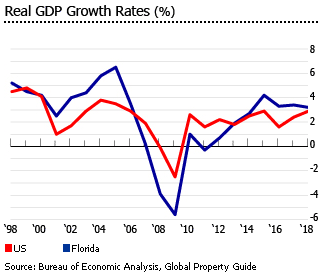
The state’s labour market continues to strengthen, with the unemployment rate falling from a post-Great Recession high of 11.3% to just 3.2% in October 2019. There were about 330,576 unemployed persons in Florida in October 2019, down 3.3% from a year earlier, according to the U.S. Bureau of Labor Statistics.
Florida has the fourth biggest economy in the country and is the third biggest state by population. The state’s economy relies heavily on tourism and agriculture.
Sources:
- Housing Vacancies and Homeownership (CPS/HVS) (US Census Bureau): https://www.census.gov/housing/hvs/data/rates.html
- Fed Decision: Interest rates left unchanged, indicates no changes through 2020 (CNBC): https://www.cnbc.com/2019/12/11/fed-decision-interest-rates.html
- Mortgage Rates (Freddie Mac): http://www.freddiemac.com/pmms/pmms_archives.html
- Mortgage Loan Debt Increases for the Seventh Straight Quarter (Experian): https://www.experian.com/blogs/ask-experian/how-much-americans-owe-on-their-mortgages-in-every-state/
- House Price Index Dataset (Federal Housing Finance Agency): https://www.fhfa.gov/DataTools/Downloads/Pages/House-Price-Index-Datasets.aspx#qpo
- U.S. Foreclosure Activity in October 2019 Climbs Upward from Previous Month (Attom Data Solutions): https://www.attomdata.com/news/market-trends/foreclosures/
- New Private Housing Units Authorized by Building Permits for Florida (Federal Reserve Bank of St. Louis): https://fred.stlouisfed.org/series/FLBPPRIV
- Florida Quarterly Residential Construction Review – Q3-2019 (HBW): http://blog.hbweekly.com/florida-quarterly-residential-construction-review-q3-2019/
- Florida Home Prices & Values (Zillow): https://www.zillow.com/fl/home-values/#
- Florida Economic Outlook: June 2019 (Wells Fargo): https://www08.wellsfargomedia.com/assets/pdf/
- RealtyHop Housing Affordability Index: October 2019 (RealtyHop): https://www.realtyhop.com/blog/realtyhop-housing-affordability-index-october-2019/
- Miami’s housing affordability crisis poses a dire threat to the city’s future, experts say (Miami Herald): https://www.miamiherald.com/news/business/real-estate-news/article235758107.html
- 2018 Profile of International Residential Real Estate Activity in Florida (Florida Realtors): https://www.floridarealtors.org/ResearchAndStatistics/Other-Research-Reports/